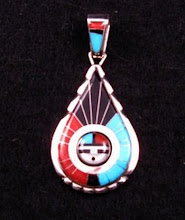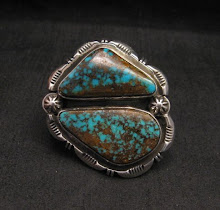The Santo Domingos make some of the most beautiful inlaid shell and turquoise jewelry in the world. They are also well known for their handmade heishi. Close to ninety percent of natives living in the Santo Domingo pueblo are self-employed and working on jewelry and /or pottery.
There are many steps to making heishi in the old traditional ways. An olivella shell, for example, is cut into squares and holes are drilled in the centers. If the squares have large corners, they would be clipped off. Then the drilled pieces are strung on a wire and then ground on a flat stone, until eventually they are round. The beads are then sanded and polished. It is a very time-consuming process, although today with lapidary equipment, the process takes a little less time than doing it all by hand. There are some artists, though, who still follow the old traditional ways.
Many of the Santo Domingos today are doing mosaics (inlays) and there are many different styles. Some jewelry starts with a shell, others with a stone. The artist then spends time selecting and cutting the stones & shells for the inlay, deciding upon the pattern and design. It may take several days for some artists just to cut the stones to have enough materials for one project. The foundation stone or shell is then cleaned so that the epoxy sticks. The inlay is then meticulously assembled piece by piece to form the finished item.
We have a nice growing selection of Santo Domingo hand made jewelry, by artists such as Rudy & Mary Coriz, Stephanie Medina, Ron & Petra Chavez, Gary & Carol Pacheco, Daniel Coriz, Molly Tenorio, Veronica Tortalita and others. Click here or on the photo to see what Santo Domingo jewelry is available.

It is important for many artists to be at the pueblo, because the creative spirit is easier to capture if you live and work within the village, neighbor to neighbor, house to house.
We had the wonderful opportunity to visit with several artists in the village a few years ago. We had stopped at a flea market near the village, looking for jewelry, but only raw material was being sold at this particular flea market. A diminutive woman asked us if we were looking for finished jewelry, and when we responded "yes", she hopped into our car and directed us to her home in the village. She whisked us inside, set up a small card table, covered it with a dark cloth, and proceeded to display samples of her beautiful handmade jewelry on the table. Her son appeared within a few minutes with several cases of his beautiful innovative inlaid jewelry. He had won several awards recently for his necklaces. We were soon joined by her husband and he was a jeweler also. Our hosts were quite gracious and, since this was our first visit to Santo Domingo, we received quite an education. We left with several bags of gorgeous necklaces, pendants and bracelets and we have been partial to Santo Domingo jewelry ever since that day.
Unfortunately, The Santo Domingos are now competing with the Philippines and China. With the advent of modern lapidary equipment, some traders have taken the Santo Domingo's necklaces to the Philippines and China to copy, making the beads there and bringing home the finished product. Buyers can avoid the imports by buying from a reputable dealer. If the price is to low to be true, it's most likely imported.
Wednesday, July 15, 2009
SANTO DOMINGO PUEBLO JEWELRY
Subscribe to:
Posts (Atom)







